The Omnipresent Surveillance Industry Has Become the New Engine for Chinese Economy
Hello, everyone, welcome to “Inconvenient Truths”. I am your host Jennifer Zeng.
The recent blackout in Texas in the US has drawn a lot of attention from all over the world. But do you know that similar blackouts have happened in many cities in China since last year? What’s the reason behind the blackouts and power shortage in China? Today let me present you some facts about how the fast-growing, omnipresent digital surveillance industry has become the so-called new engine for the Chinese economy, as well as the “electricity-eating tiger”, as the Chinese people call it.
A “State of War” Status for Power Supply
In late 2020 and early 2021, China saw its first orange alert for a cold wave in nearly four years. Amidst the severe coldness, some areas in China were experiencing power outages and restrictions, including Hunan, Zhejiang, Jiangxi, and Inner Mongolia, which is China’s major province of electricity out feeding and a major producer of coal.
In Changsha City, Hunan Province, some offices had to turn off their elevators, and many people had to climb 20 to 30 floors of stairs to work. The Hunan Electric Power Company even announced a “state of war” status for power supply. Let’s Show Picture 1. This is a building in Changsha with most of the rooms in the buildings in darkness.
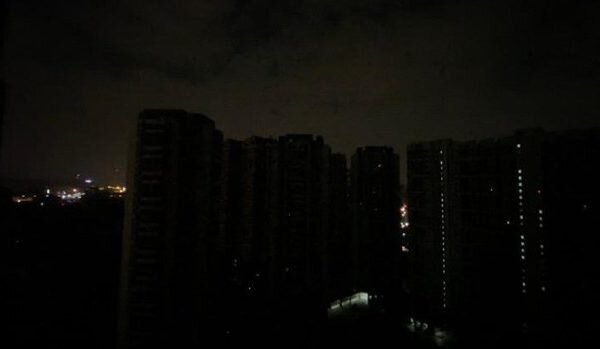
Changsha city in darkness
As a matter of fact, for the past 18 years, China has been aggressively building power plants. By the end of 2020, China’s installed power generation capacity was more than six times the 2002 level.
Apart from that, China’s coal power industry has actually encountered severe overcapacity.
So why did China encounter a power shortage?
The official explanations from the CCP are:
-
The resumption of industrial production increased the demand for electricity;
-
The extreme cold weather increased the demand;
-
The limited external power supply and the breakdown of the engine.
Are these really the case?
2. “New Infrastructure” and “Digital Economy”
According to a report by the State-owned Assets Supervision and Administration Commission of the State Council, the increase in China’s electricity consumption reflects the “strong recovery” of China’s economy after the pandemic. And if one looks more closely, much of the increase came from the “digital economy” and “smart manufacturing”, which are closely related to the “new infrastructure construction”.
What is the “new infrastructure”?
The traditional infrastructure mainly refers to roads, railroads, bridges, airports, ports, power grids and other facilities, while the CCP’s “new infrastructure” refers to digital infrastructure such as 5G base stations, Internet of Things, data centers, etc. These infrastructures can digitize information and business activities; and an economic system based on digital computing technology is referred to as “digital economy”.
“Developing digital economy” is one of the CCP’s goals included in its 14th 5-Year Plan and National Economic and Social Development and the Visionary Goals for 2035.
In the CCP’s report we just mentioned, two “outstanding” “digital manufacturers” including Lens Technology and Sunward Intelligent were specially mentioned and praised for their “rapid growth” in electricity consumption. Their average daily electricity consumption increased by 53% and 72% year-on-year respectively, which “greatly contributed to the increase of local electricity consumption”.
Please note that Hunan and Zhejiang, which were praised in this report, were also places that suffered badly from power shortages in the winter of 2020.
This official report also came to an important conclusion: the “digital economy” and “smart manufacturing” industries have become the new driving force for electricity consumption growth.
Another report by the “National Electricity Supply and Demand Analysis and Forecast Report 2020-2021” also confirms this.
The report says, in 2020, the electricity consumption of the primary industry increased by 10.2% year-on-year. In the meantime, “due to the rapid growth of the application of new technologies such as big data, cloud computing and the Internet of Things”, the electricity consumption in the information transmission, software and information technology service sector in China grew by 23.9% year-on-year.
3. Ulanqab in Inner Mongolia: The “Big Data” City of Electricity Shortage
Now, let’s do a case study of Inner Mongolia city Ulanqab. Let’s Show Picture 2. This is a map of China, the little red dot at the north near Mongolia is where Ulanqab is located.
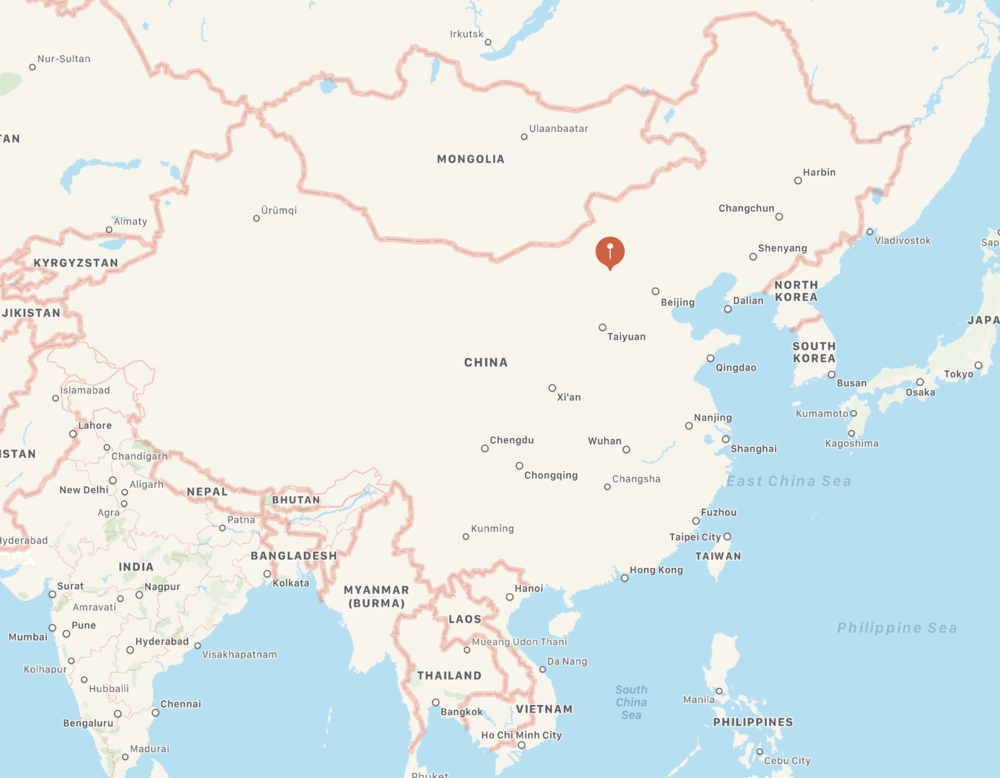
Ulanqab’s location.
Inner Mongolia Autonomous Region is a major energy-rich province in China. It not only supplies electricity to 10 other provinces and regions, but is also one of China’s major coal production bases, which produces more than a quarter of the country’s coal.
However, Inner Mongolia was also the first place in China to experience a power shortage in November 2020.
So what happened?
Perhaps a story published in Sep. last year can tell us the secret.
The title of this story is: “Ulanqab: A ‘Lonely’ City Surrounded by Big Data“. The article describes how Ulanqab relies on science and technology to develop.
The article says, the labels for this small Inner Mongolian city of 2.87 million people were once a farming & herding area, windy and poor. However, since Huawei decided to establish a data center in this city in 2013, it has not only become the northern base of the national big data disaster preparedness center, but also a big data center for many companies such as Alibaba and Huaishou.
According to Ulanqab City Government, the city’s gross regional product in 2019 was 80.84 billion yuan ($12.46 billion) , of which the tertiary industry contributed 45%.
However, in 2013, the year when the big data center was established in Ulanqab, the tertiary industry only contributed 29.4% to the gross regional product.
This is to say, the percentage of the tertiary industry has increased significantly from 29.4% in 2013 to 45% in 2019. This shows that the data center contributed greatly to this increase.
As a matter of fact, the “big data industry” has changed this city from a “windy and poor” farming and herding area with 76.3% forest and grass coverage into a “Cloud Valley on the Grassland”. That is how it is described now.
According to the Ulanqab city government, in 2020, electricity consumption in the information transmission, software and information technology service industry, which includes new technologies such as “big data and cloud computing”, increased by 24.9% compared to the same period last year.
The rapid increase in electricity demand, coupled with the increase in electricity consumption by local residents in the winter, had led Ulanqab to become the first city to announce a “power shortage” last November.
Data Centers: Energy Consumption Giants
Next, we have something to share about the data centers.
Whenever a data center is mentioned, people often think about a row of computer racks, which seem to consume much less energy than the steel plants with their big smoking chimneys.
Is that the case? As a matter of fact, compared to ordinary server rooms, data centers have very high requirements in terms of temperature, humidity, magnetic field interference, and other conditions, which are all very demanding.
Apart from uninterrupted power, a lot of equipment, such as air conditioners and chillers is also required to assist with lighting, cooling, etc. As a matter of fact, electricity accounts for 56.7% of the operating cost of data centers.
According to the CCP’s mouthpiece People’s Daily, as early as 2016, the power consumption of China’s data centers had exceeded the annual power generation of the Three Gorges Dam, and by 2017, the total power consumption of China’s data centers exceeded the total power generation of the Three Gorges Dam and Gezhouba Power Plant.
In 2018, the total electricity consumption of China’s data centers was more than the electricity consumption of the whole city of Shanghai, a city with a population of 26 million.
As to Hunan Province, which was the first to announced a “Wartime Status” for power supply last December, at the beginning of 2020, the provincial government had announced 86 provincial-level key projects for the development of big data and blockchain industries, calling for the vigorous development of “big data”.
In Zhejiang province, where the power supply had once been disconnected or limited, many data centers have been established too. In Hangzhou city alone, there are more than 50 data centers in operation.
The 5G base stations, which help collect big data, are also called “electricity-eating tigers” by many Chinese people. The power consumption level of 5G base stations is more than 9 times that of 4G.
In the meantime, the coverage radius of 5G base stations is 300 to 500 meters. So at least three 5G base stations are required to cover the area of a 4G base station under the same condition.
In August 2020, China Unicom’s Luoyang Branch shut down some of its 5G base stations during some time slots in the night due to high electricity costs, sending a signal to the world about the high power consumption of 5G base stations.
According to CCP’s official report, as of Nov. last year, 700 K 5G base stations have been built in China, linking more than 180 million 5G terminals. The pace of 5G construction is increasing rapidly, and more than 1 million 5G base stations will be built in 2021.
It is also estimated that by 2025, 5G base stations in China could consume 17 times as much electricity as they did in 2020.
5G and digital hubs not only consume huge amounts of power, but also help the CCP build an Orwellian society with omnipresent surveillance.
Contributions of “New Infrastructure” And “Digital Economy”
After the outbreak of the CCP virus in early 2020, “new infrastructures” such as 5G, artificial intelligence, big data, cloud computing, and the Internet of Things were given high priority by the CCP and were directly included in the CCP government work report.
According to an article published by Xinhua in April, 2020, the pandemic was a direct motivation for the development of “new infrastructure”. The article claims that the energy efficiency of traditional infrastructure is diminishing and new infrastructure represented by digital infrastructure can become a new growth engine for the CCP’s economy and can “effectively cope with the downward pressure on the economy.”
The “new infrastructure” can also attract a large amount of investment, which can further boost economic growth.
According to Xinhua, as of May 2020, more than 20 provinces in China have launched “new infrastructure” plans totaling trillions of yuan.
For the CCP, the deployment of “new infrastructure” projects such as 5G, artificial intelligence, and data centers is “killing two birds with one stone”. It can not only provide an omnipresent surveillance network, but also become a driving force for the economy.
The Omnipresent Surveillance Network
How does the CCP’s omnipresent surveillance network operate? We just need to take a look at Huawei’s CampusGo as an example. Let’s show Picture 3. It is a screenshot of CampusGo from Huawei’s website to show what this system can do.
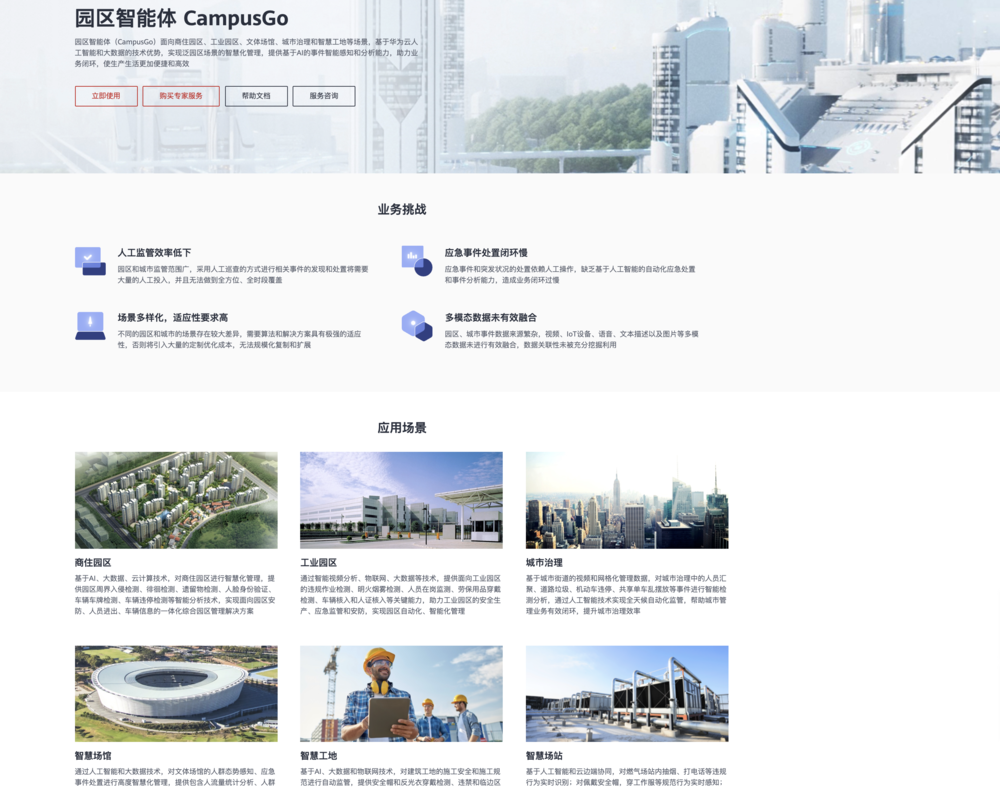
Screenshot of CampusGo
CampusGo is presented as a model smart system to provide “management” for commercial and residential buildings, as well as urban governance, etc. It can provide intrusion detection, remnant detection, facial identity verification, wandering detection, vehicle license plate recognition and other intelligent analysis technologies, as well as leading technologies such as intelligent algorithms and deep learning to ensure high-precision perception and processing of information of faces, vehicles, events and behaviors.
Huawei Cloud also launched a product based on 5G technology, which is called 5G “Smart Security Solutions“. Let’s show Picture 4. It is a screenshot from Huawei’s website to show what this “Smart City Solutions” can do.
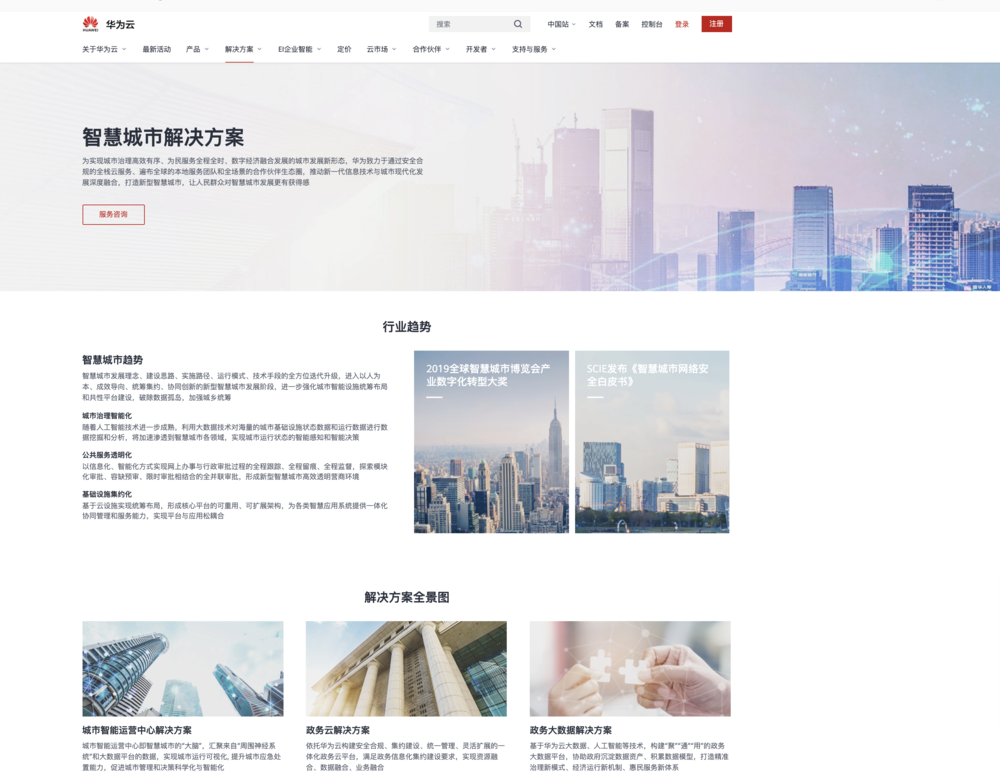
Screenshot of Smart City Solutions
Basically, the solution includes the use of drones, robots, 5G AR glasses, overhead cameras, etc., to constantly send back HD videos from key areas to the cloud platform through the 5G network, and then to analyze, identify, and record people and events, etc.
So the essence of CampusGo and 5G Smart Security Solutions is to monitor, record and analyze all people, things and events through cameras, 5G technology, artificial intelligence and data centers, etc.
In the meantime, all the data and information collected can be used and abused by the CCP.
As a matter of fact, all of China has become a “technology laboratory” for the CCP. 54% of the world’s surveillance cameras were in China by the end of 2019.
Also, among the top 10 cities with the highest density of surveillance in the world, six cities are in China, including Beijing, Harbin, Xiamen, Chengdu, Taiyuan and Kunming, with the number of cameras in Beijing reaching 1.15 million, the highest in the world.
In addition to face recognition, the CCP also released what it says is the world’s first “gait recognition” surveillance system in 2019. In other words, the system can identify a person’s walking posture even if this person’s face is covered.
The CCP can also use various methods to monitor people, such as voice recognition, emotion recognition, and cell phone tapping.
So the point is, no matter where you go in China, you will never be able to get out of the smart big data net of the CCP.
Surveillance: The New Engine of China’s Economic Growth
In January this year, the CCP announced an annual GDP growth rate of 2.3% for 2020, and said that China had thus become the only major economy in the world to record positive GDP growth. Among all sectors, the information transmission, software and information technology services sector, which includes “big data and cloud computing,” grew the fastest, up 16.9% year-on-year.
In July 2020, China Academy of Information and Communications Technology released its white paper on Digital Economy Development in China (2020)
The White Paper says, “the year 2019 saw the added value of the digital economy in China hitting RMB 35.8 trillion, accounting for 36.2% of GDP”. “On a comparable basis, the nominal growth of China’s digital economy in 2019 was 15.6%, about 7.85% higher than that of GDP in the same period. ”
Let’s show Picture 5. It is from the White Paper we just mentioned. The red line is the growth of the digital economy, and the darker blue line is the GDP growth. You can see that from the year 2012, the growth of the digital economy has been much higher than the GDP growth, and the growth of all other sectors.
So the CCP official said that “digital economy has become a new engine for high-quality development”.
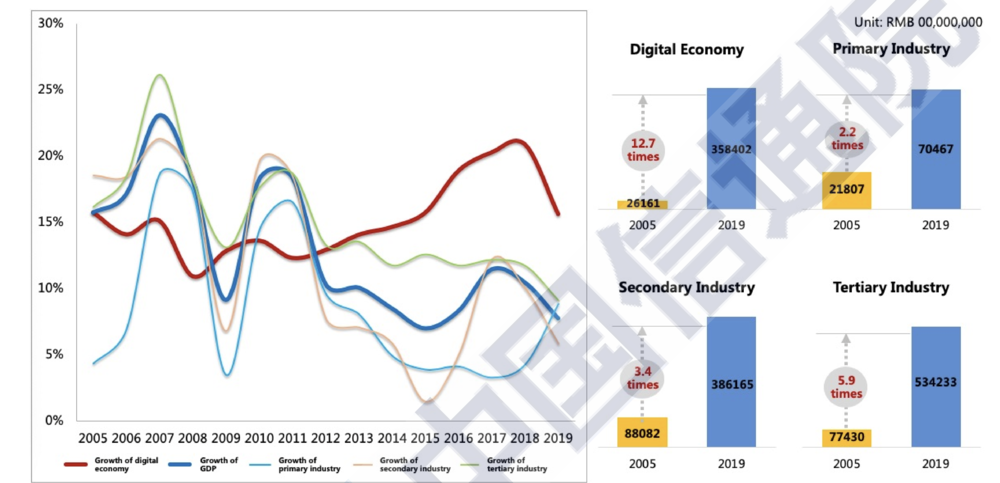
“Digital Economy” and Human Rights Abuses
Behind the development of the digital economy is the prevalence of the CCP’s surveillance and human rights abuses. After laying out an omnipresent surveillance net, the CCP closely tracks what 1.4 billion people in China say, see, and do every day, every minute, and every second, analyzing their behavior, economic activities, daily consumption, and even culture and entertainment activities, etc.
In the meantimes, the CCP has expanded its surveillance network overseas by helping international organizations, such as the United Nations, to establish data centers.
On October 21, 2019, Foreign Policy magazine published an article “China’s Surveillance State Has Tens of Millions of New Targets” and suggests that the CCP is working with the Ministry of Public Security and technology companies to collect detailed information on so-called “key individuals ” in a ” ” database and share it in real time to crackdown on people.
“Key individuals” are the main targets of the CCP’s suppression, including Falun Gong practitioners, petitioners, human rights defenders (including human rights lawyers), dissidents, protesters, and ethnic minority groups, such as Uighurs. The number of “key individuals” under surveillance has increased significantly as the scope of the CCP’s persecution has expanded when more and more people start to criticize the CCP.
Unfortunately, what many people in the world see is the “splendid” GDP growth of the CCP, and quite a lot overseas investors are still being attracted by the economic “achievements” of the CCP and thus keeping on investing in China.
Well, that’s all for today’s “inconvenient truths”. Please do subscribe to and share my channel, like my videos, leave a comment to boost my videos. The views of my videos have dropped dramatically since Jan. 6. I have also lost more than 500 subscribers. Usually the subscriptions kept growing when I did new programs. But now I keep losing subscribers. People told me that they got unsubscribed without their knowledge. So please do help me to fight the censorship.
Thank you very much for your support. See you next time!
2/21/2021
Truth Saves Lives. Subscribe and support! 真相能救命。請支持!
Donate to me directly 直接捐款:https://donorbox.org/inconvenient-truths-by-jennifer-zeng
Subscribestar 會員頻道: https://bit.ly/3fEzeJB
YouTube 油管:bit.ly/3b87DPj
GoFundme 衆籌:https://bit.ly/2zx6LVw
Patreon 網站:https://bit.ly/3cvBy3H
Paypal 捐款:http://paypal.me/JenniferZeng97
Bitcoin 捐款:bc1qlkkvwyvw96x3xx6jgzkhlnnv0nv3d9vm078vfd

The Secret Behind the Blackouts Across China
The Omnipresent Surveillance Industry Has Become the New Engine for Chinese Economy
Hello, everyone, welcome to “Inconvenient Truths”. I am your host Jennifer Zeng.
The recent blackout in Texas in the US has drawn a lot of attention from all over the world. But do you know that similar blackouts have happened in many cities in China since last year? What’s the reason behind the blackouts and power shortage in China? Today let me present you some facts about how the fast-growing, omnipresent digital surveillance industry has become the so-called new engine for the Chinese economy, as well as the “electricity-eating tiger”, as the Chinese people call it.
A “State of War” Status for Power Supply
In late 2020 and early 2021, China saw its first orange alert for a cold wave in nearly four years. Amidst the severe coldness, some areas in China were experiencing power outages and restrictions, including Hunan, Zhejiang, Jiangxi, and Inner Mongolia, which is China’s major province of electricity out feeding and a major producer of coal.
In Changsha City, Hunan Province, some offices had to turn off their elevators, and many people had to climb 20 to 30 floors of stairs to work. The Hunan Electric Power Company even announced a “state of war” status for power supply. Let’s Show Picture 1. This is a building in Changsha with most of the rooms in the buildings in darkness.
Changsha city in darkness
As a matter of fact, for the past 18 years, China has been aggressively building power plants. By the end of 2020, China’s installed power generation capacity was more than six times the 2002 level.
Apart from that, China’s coal power industry has actually encountered severe overcapacity.
So why did China encounter a power shortage?
The official explanations from the CCP are:
The resumption of industrial production increased the demand for electricity;
The extreme cold weather increased the demand;
The limited external power supply and the breakdown of the engine.
Are these really the case?
2. “New Infrastructure” and “Digital Economy”
According to a report by the State-owned Assets Supervision and Administration Commission of the State Council, the increase in China’s electricity consumption reflects the “strong recovery” of China’s economy after the pandemic. And if one looks more closely, much of the increase came from the “digital economy” and “smart manufacturing”, which are closely related to the “new infrastructure construction”.
What is the “new infrastructure”?
The traditional infrastructure mainly refers to roads, railroads, bridges, airports, ports, power grids and other facilities, while the CCP’s “new infrastructure” refers to digital infrastructure such as 5G base stations, Internet of Things, data centers, etc. These infrastructures can digitize information and business activities; and an economic system based on digital computing technology is referred to as “digital economy”.
“Developing digital economy” is one of the CCP’s goals included in its 14th 5-Year Plan and National Economic and Social Development and the Visionary Goals for 2035.
In the CCP’s report we just mentioned, two “outstanding” “digital manufacturers” including Lens Technology and Sunward Intelligent were specially mentioned and praised for their “rapid growth” in electricity consumption. Their average daily electricity consumption increased by 53% and 72% year-on-year respectively, which “greatly contributed to the increase of local electricity consumption”.
Please note that Hunan and Zhejiang, which were praised in this report, were also places that suffered badly from power shortages in the winter of 2020.
This official report also came to an important conclusion: the “digital economy” and “smart manufacturing” industries have become the new driving force for electricity consumption growth.
Another report by the “National Electricity Supply and Demand Analysis and Forecast Report 2020-2021” also confirms this.
The report says, in 2020, the electricity consumption of the primary industry increased by 10.2% year-on-year. In the meantime, “due to the rapid growth of the application of new technologies such as big data, cloud computing and the Internet of Things”, the electricity consumption in the information transmission, software and information technology service sector in China grew by 23.9% year-on-year.
3. Ulanqab in Inner Mongolia: The “Big Data” City of Electricity Shortage
Now, let’s do a case study of Inner Mongolia city Ulanqab. Let’s Show Picture 2. This is a map of China, the little red dot at the north near Mongolia is where Ulanqab is located.
Ulanqab’s location.
Inner Mongolia Autonomous Region is a major energy-rich province in China. It not only supplies electricity to 10 other provinces and regions, but is also one of China’s major coal production bases, which produces more than a quarter of the country’s coal.
However, Inner Mongolia was also the first place in China to experience a power shortage in November 2020.
So what happened?
Perhaps a story published in Sep. last year can tell us the secret.
The title of this story is: “Ulanqab: A ‘Lonely’ City Surrounded by Big Data“. The article describes how Ulanqab relies on science and technology to develop.
The article says, the labels for this small Inner Mongolian city of 2.87 million people were once a farming & herding area, windy and poor. However, since Huawei decided to establish a data center in this city in 2013, it has not only become the northern base of the national big data disaster preparedness center, but also a big data center for many companies such as Alibaba and Huaishou.
According to Ulanqab City Government, the city’s gross regional product in 2019 was 80.84 billion yuan ($12.46 billion) , of which the tertiary industry contributed 45%.
However, in 2013, the year when the big data center was established in Ulanqab, the tertiary industry only contributed 29.4% to the gross regional product.
This is to say, the percentage of the tertiary industry has increased significantly from 29.4% in 2013 to 45% in 2019. This shows that the data center contributed greatly to this increase.
As a matter of fact, the “big data industry” has changed this city from a “windy and poor” farming and herding area with 76.3% forest and grass coverage into a “Cloud Valley on the Grassland”. That is how it is described now.
According to the Ulanqab city government, in 2020, electricity consumption in the information transmission, software and information technology service industry, which includes new technologies such as “big data and cloud computing”, increased by 24.9% compared to the same period last year.
The rapid increase in electricity demand, coupled with the increase in electricity consumption by local residents in the winter, had led Ulanqab to become the first city to announce a “power shortage” last November.
Data Centers: Energy Consumption Giants
Next, we have something to share about the data centers.
Whenever a data center is mentioned, people often think about a row of computer racks, which seem to consume much less energy than the steel plants with their big smoking chimneys.
Is that the case? As a matter of fact, compared to ordinary server rooms, data centers have very high requirements in terms of temperature, humidity, magnetic field interference, and other conditions, which are all very demanding.
Apart from uninterrupted power, a lot of equipment, such as air conditioners and chillers is also required to assist with lighting, cooling, etc. As a matter of fact, electricity accounts for 56.7% of the operating cost of data centers.
According to the CCP’s mouthpiece People’s Daily, as early as 2016, the power consumption of China’s data centers had exceeded the annual power generation of the Three Gorges Dam, and by 2017, the total power consumption of China’s data centers exceeded the total power generation of the Three Gorges Dam and Gezhouba Power Plant.
In 2018, the total electricity consumption of China’s data centers was more than the electricity consumption of the whole city of Shanghai, a city with a population of 26 million.
As to Hunan Province, which was the first to announced a “Wartime Status” for power supply last December, at the beginning of 2020, the provincial government had announced 86 provincial-level key projects for the development of big data and blockchain industries, calling for the vigorous development of “big data”.
In Zhejiang province, where the power supply had once been disconnected or limited, many data centers have been established too. In Hangzhou city alone, there are more than 50 data centers in operation.
The 5G base stations, which help collect big data, are also called “electricity-eating tigers” by many Chinese people. The power consumption level of 5G base stations is more than 9 times that of 4G.
In the meantime, the coverage radius of 5G base stations is 300 to 500 meters. So at least three 5G base stations are required to cover the area of a 4G base station under the same condition.
In August 2020, China Unicom’s Luoyang Branch shut down some of its 5G base stations during some time slots in the night due to high electricity costs, sending a signal to the world about the high power consumption of 5G base stations.
According to CCP’s official report, as of Nov. last year, 700 K 5G base stations have been built in China, linking more than 180 million 5G terminals. The pace of 5G construction is increasing rapidly, and more than 1 million 5G base stations will be built in 2021.
It is also estimated that by 2025, 5G base stations in China could consume 17 times as much electricity as they did in 2020.
5G and digital hubs not only consume huge amounts of power, but also help the CCP build an Orwellian society with omnipresent surveillance.
Contributions of “New Infrastructure” And “Digital Economy”
After the outbreak of the CCP virus in early 2020, “new infrastructures” such as 5G, artificial intelligence, big data, cloud computing, and the Internet of Things were given high priority by the CCP and were directly included in the CCP government work report.
According to an article published by Xinhua in April, 2020, the pandemic was a direct motivation for the development of “new infrastructure”. The article claims that the energy efficiency of traditional infrastructure is diminishing and new infrastructure represented by digital infrastructure can become a new growth engine for the CCP’s economy and can “effectively cope with the downward pressure on the economy.”
The “new infrastructure” can also attract a large amount of investment, which can further boost economic growth.
According to Xinhua, as of May 2020, more than 20 provinces in China have launched “new infrastructure” plans totaling trillions of yuan.
For the CCP, the deployment of “new infrastructure” projects such as 5G, artificial intelligence, and data centers is “killing two birds with one stone”. It can not only provide an omnipresent surveillance network, but also become a driving force for the economy.
The Omnipresent Surveillance Network
How does the CCP’s omnipresent surveillance network operate? We just need to take a look at Huawei’s CampusGo as an example. Let’s show Picture 3. It is a screenshot of CampusGo from Huawei’s website to show what this system can do.
Screenshot of CampusGo
CampusGo is presented as a model smart system to provide “management” for commercial and residential buildings, as well as urban governance, etc. It can provide intrusion detection, remnant detection, facial identity verification, wandering detection, vehicle license plate recognition and other intelligent analysis technologies, as well as leading technologies such as intelligent algorithms and deep learning to ensure high-precision perception and processing of information of faces, vehicles, events and behaviors.
Huawei Cloud also launched a product based on 5G technology, which is called 5G “Smart Security Solutions“. Let’s show Picture 4. It is a screenshot from Huawei’s website to show what this “Smart City Solutions” can do.
Screenshot of Smart City Solutions
Basically, the solution includes the use of drones, robots, 5G AR glasses, overhead cameras, etc., to constantly send back HD videos from key areas to the cloud platform through the 5G network, and then to analyze, identify, and record people and events, etc.
So the essence of CampusGo and 5G Smart Security Solutions is to monitor, record and analyze all people, things and events through cameras, 5G technology, artificial intelligence and data centers, etc.
In the meantime, all the data and information collected can be used and abused by the CCP.
As a matter of fact, all of China has become a “technology laboratory” for the CCP. 54% of the world’s surveillance cameras were in China by the end of 2019.
Also, among the top 10 cities with the highest density of surveillance in the world, six cities are in China, including Beijing, Harbin, Xiamen, Chengdu, Taiyuan and Kunming, with the number of cameras in Beijing reaching 1.15 million, the highest in the world.
In addition to face recognition, the CCP also released what it says is the world’s first “gait recognition” surveillance system in 2019. In other words, the system can identify a person’s walking posture even if this person’s face is covered.
The CCP can also use various methods to monitor people, such as voice recognition, emotion recognition, and cell phone tapping.
So the point is, no matter where you go in China, you will never be able to get out of the smart big data net of the CCP.
Surveillance: The New Engine of China’s Economic Growth
In January this year, the CCP announced an annual GDP growth rate of 2.3% for 2020, and said that China had thus become the only major economy in the world to record positive GDP growth. Among all sectors, the information transmission, software and information technology services sector, which includes “big data and cloud computing,” grew the fastest, up 16.9% year-on-year.
In July 2020, China Academy of Information and Communications Technology released its white paper on Digital Economy Development in China (2020)
The White Paper says, “the year 2019 saw the added value of the digital economy in China hitting RMB 35.8 trillion, accounting for 36.2% of GDP”. “On a comparable basis, the nominal growth of China’s digital economy in 2019 was 15.6%, about 7.85% higher than that of GDP in the same period. ”
Let’s show Picture 5. It is from the White Paper we just mentioned. The red line is the growth of the digital economy, and the darker blue line is the GDP growth. You can see that from the year 2012, the growth of the digital economy has been much higher than the GDP growth, and the growth of all other sectors.
So the CCP official said that “digital economy has become a new engine for high-quality development”.
“Digital Economy” and Human Rights Abuses
Behind the development of the digital economy is the prevalence of the CCP’s surveillance and human rights abuses. After laying out an omnipresent surveillance net, the CCP closely tracks what 1.4 billion people in China say, see, and do every day, every minute, and every second, analyzing their behavior, economic activities, daily consumption, and even culture and entertainment activities, etc.
In the meantimes, the CCP has expanded its surveillance network overseas by helping international organizations, such as the United Nations, to establish data centers.
On October 21, 2019, Foreign Policy magazine published an article “China’s Surveillance State Has Tens of Millions of New Targets” and suggests that the CCP is working with the Ministry of Public Security and technology companies to collect detailed information on so-called “key individuals ” in a ” ” database and share it in real time to crackdown on people.
“Key individuals” are the main targets of the CCP’s suppression, including Falun Gong practitioners, petitioners, human rights defenders (including human rights lawyers), dissidents, protesters, and ethnic minority groups, such as Uighurs. The number of “key individuals” under surveillance has increased significantly as the scope of the CCP’s persecution has expanded when more and more people start to criticize the CCP.
Unfortunately, what many people in the world see is the “splendid” GDP growth of the CCP, and quite a lot overseas investors are still being attracted by the economic “achievements” of the CCP and thus keeping on investing in China.
Well, that’s all for today’s “inconvenient truths”. Please do subscribe to and share my channel, like my videos, leave a comment to boost my videos. The views of my videos have dropped dramatically since Jan. 6. I have also lost more than 500 subscribers. Usually the subscriptions kept growing when I did new programs. But now I keep losing subscribers. People told me that they got unsubscribed without their knowledge. So please do help me to fight the censorship.
Thank you very much for your support. See you next time!
2/21/2021
Truth Saves Lives. Subscribe and support! 真相能救命。請支持!
Donate to me directly 直接捐款:https://donorbox.org/inconvenient-truths-by-jennifer-zeng
Subscribestar 會員頻道: https://bit.ly/3fEzeJB
YouTube 油管:bit.ly/3b87DPj
GoFundme 衆籌:https://bit.ly/2zx6LVw
Patreon 網站:https://bit.ly/3cvBy3H
Paypal 捐款:http://paypal.me/JenniferZeng97
Bitcoin 捐款:bc1qlkkvwyvw96x3xx6jgzkhlnnv0nv3d9vm078vfd